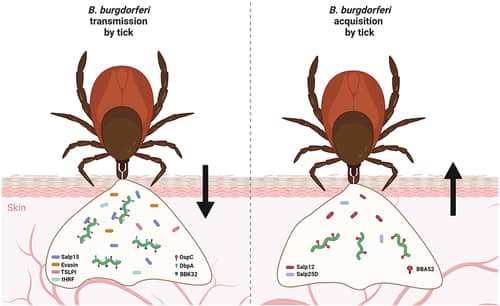
Lyme disease is a bacterial infection caused by the bacteria Borrelia burgdorferi. It is transmitted to humans through the bite of an infected black-legged tick, also known as deer tick. These ticks are commonly found in grassy and wooded areas, especially in the Northwest, Midwest, and Pacific Coast regions of the United States.
Getting informed and taking proactive steps is crucial to improve their health. Let’s deep dive into this blog and understand more on the symptoms, diagnosis, and treatment options of lyme illness.
How does Borrelia burgdorferi cause infection in humans?
- Borrelia burgdorferi, the bacteria responsible for Lyme disease, is transmitted to humans through the bite of infected black-legged ticks.
- For transmission to occur, the tick must remain attached to the skin and feed for 36 to 48 hours. During this time, the bacteria travel from the tick’s midgut to its salivary glands and are introduced into the human bloodstream.
- Once it enters the body, Borrelia burgdorferi doesn’t stay localized. Instead, it spreads by entering the bloodstream and migrating to different tissues, including joints, the heart, and the nervous system.
- One of the reasons Borrelia burgdorferi is so persistent is its ability to evade the immune system. It does this by changing its outer surface proteins, allowing it to hide from immune detection.
- This bacteria can also burrow into cells and tissues, making it difficult for the immune system, and even antibiotics in some cases, to eliminate it.

How do ticks carry Borrelia burgdorferi bacteria?
Ticks are the primary carriers of Borrelia burgdorferi, the bacteria that cause Lyme disease.
- The process starts with a tick feeding on an infected animal, usually a small mammal, like birds, which serve as a natural reservoir for the bacteria.
- When the tick bites and draws blood from the host, it picks up the Borrelia burgdorferi bacteria and stores it in its guts.
- Once the tick becomes affected, it can transmit the bacteria to humans. This happens when the tick attaches to a human and begins feeding over a period.
- As the ticks feed, the bacteria move from the tick midguts to its salivary glands and are passed into the human bloodstream through the tick’s saliva.
- In short, ticks act as a bridge between the natural carriers of the bacteria and humans, spreading the infection during prolonged feeding. Preventing tick bites and removing ticks promptly are essential steps in reducing the risk of Lyme disease.

What are the symptoms caused by Borrelia burgdorferi?
Symptoms caused by Borrelia burgdorferi, typically classified into three stages:
Stage 1 (Early Localized Lyme Disease)
Within 3 to 30 days after a tick bite.
- Erythema migrans rash – Bull’s eye, this rash appears at the site of the tick bite.
- Flu-like symptoms – These can include fever, chills, fatigue, swollen lymph nodes, muscle and joint aches.
Stage 2 (Early Disseminated Lyme Disease)
Weeks to months post-infection, the bacteria may spread.
- Severe headaches and neck stiffness
- Additional Erythema migrans rashes
- Arthritis
- Heart palpitations
- Nerve pain
- Problems with short-term memory
Stage 3 (Late Disseminated Lyme Disease)
Months to years after the initial infection.
- Severe arthritis
- Neurological symptoms
- Chronic fatigue
It is important to know that Lyme disease symptoms can vary widely among individuals, and not everyone will face all symptoms or progress through all stages.
Can Borrelia burgdorferi cause chronic Lyme disease?
Borrelia burgdorferi, the bacteria responsible for Lyme disease, can lead to chronic illness in some individuals if the symptoms are not diagnosed and treated early.
When Lyme disease is not identified and addressed during its early stages, the bacteria can spread throughout the body and persist, potentially causing Chronic Lyme disease. This condition is often marked by ongoing symptoms such as fatigue, joint pain, and neurological complications.
Why is Borrelia burgdorferi important in tick-borne disease research?
Borrelia burgdorferi is the main bacteria responsible for Lyme disease, the most prevalent tick borne illness in North America. Transmitted through the bite of infected black-legged ticks, this can lead to diverse symptoms affecting the skin, heart, joints, and the nervous system.
Understanding Borrelia burgdorferi is important for many reasons:
- Not all strains of bacteria are equal. Some are more aggressive than others.
- Borrelia burgdorferi can trigger immune responses that might lead to conditions like Lyme arthritis. Bacteria may not just cause direct infection but could also be involved in autoimmune reactions.
Borrelia burgdorferi form persister cells that are highly resistant to standard antibiotics. This makes treatment more complicated.
Wrapping Up!
- Borrelia burgdorferi plays a main role in Lyme disease, shaping how the infection spreads, how it affects the body, and how it is treated.
- Its ability to hide from the immune system, resist antibiotics, and impact multiple parts of the body makes it a major focus in tick-borne disease.
- With Lyme disease cases on the rise, awareness is important. Steps such as avoiding tick-heavy areas, using repellant, and checking for ticks after outdoor activities.
Reference
- GLA A at. Why Is Lyme Disease So Hard to Treat?. www.global lyme alliance.org. Availablefrom: https://www.globallymealliance.org/blog/why-is-lyme-disease-so-hard-to-treat
- About Lyme | Lyme Disease Statistics, Cases, & Prevalence
- How to Treat Lyme Disease: A Patient Reflects. Globallymealliance.org. 2024 [cited 2025 May 12]. Available from: https://www.globallymealliance.org/blog/reflections-on-how-to-treat-lyme-disease


